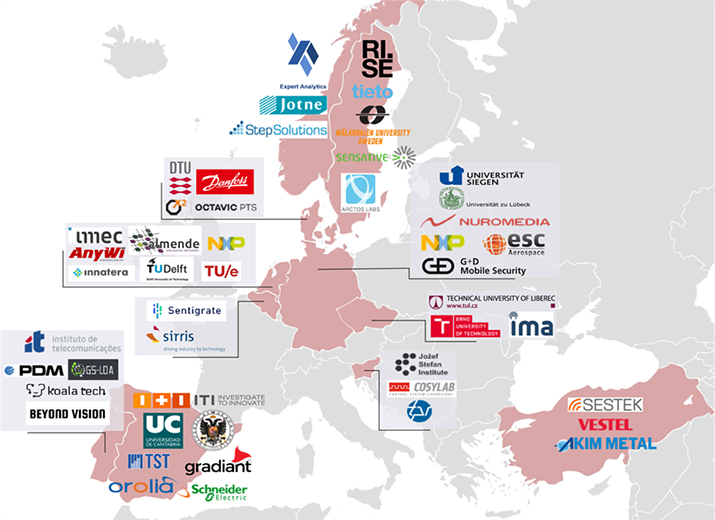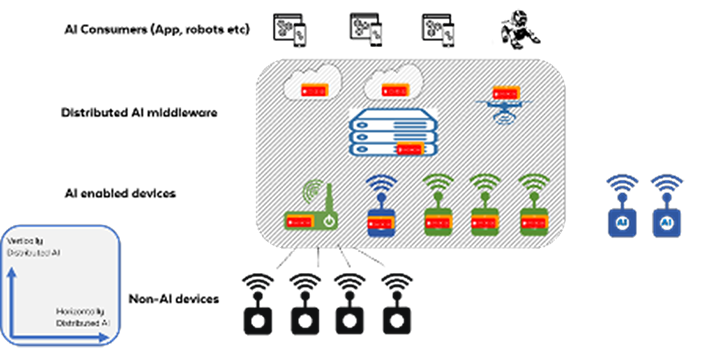Artificial Intelligence Enabled Distributed Edge Computing for Internet of Things
In recent years, technological developments in consumer electronics and industrial applications have advanced rapidly. As a result, more and smaller networked devices can collect and process data anywhere. This Internet of Things (IoT) is a revolutionary change for many sectors like building, automotive, digital industry, energy, healthcare. As a result, the amount of data generated at the Edge level has increased dramatically, resulting in higher network bandwidth requirements. In the meantime, with the emergence of novel applications, such as automated driving, lower network latency is required.
The new paradigm of Edge Computing (EC) provides new solutions by bringing resources closer to the user keeping sensitive & private data on the device. As a result, it provides low latency, energy efficiency, and scalability compared to cloud services while reducing the network bandwidth. This, in addition, brings cost savings. Furthermore, EC guarantees the quality of service when dealing with a massive amount of data for cloud computing [1,2].
At the same time, Artificial Intelligence (AI) applications based on machine learning (especially deep learning algorithms) are being fuelled by advances in models, processing power, and big data. In Cisco's annual report (2018-2023) [3], they asked 83 organizations when all reported that they have edge computing use cases where artificial intelligence, the internet of things, and 5G had higher portions. The huge increase of devices at the network edge drives the need for enterprises to manage and analyze data from IoT endpoints. Shifting traffic from the network core to the edge affects computing and communications architectures. To have a successful edge computing strategy, it is important to ensure the overall infrastructure is efficiently managed.
The developments of AI applications mostly require data processing in centralized cloud locations and hence cannot be used for applications where milliseconds matter or for safety-critical applications. For example, as the sensors and cameras mounted on an autonomous vehicle generate about a gigabyte of data per second, it is difficult, if not impossible, to upload this data and get instructions from the cloud in real-time. The same situation is valid for face recognition applications, where they have high temporal requirements for online or offline processing. Moreover, edge computing offers security benefits due to wider data distribution at the edge level. Reducing the distance data has to travel for processing means decreasing the opportunities for trackers and hackers to intercept it during transmission and preserves its privacy. With more data remaining at the edges of the network, central servers are also less likely to become targets for cyberattacks. This has led to a growing interest in Federated Learning (FL). This promising distributed learning paradigm allows multiple parties to jointly train a global ML model on their combined data without any participants revealing their data to a centralized server [4].
DAIS Project Objectives
DAIS is a huge step forward in artificial intelligence and edge computing. DAIS aims to provide edge computing architecture, including hardware and software for industrial applications. DAIS is a pan-European effort spanning three years with a total budget of €33 million and a consortium of 47 partners from 11 countries, shown in Figure 1. Coordinated by RISE, a research institute of Sweden, and with the support of Europe's industry, Europe's leading Research Organizations, the European Union via the KDT Joint Undertaking, and the participating national funding agencies, it is possible to bring together European and International key players to the benefit of Europe's economy and society.

Figure 1: DAIS project consortium.
DAIS intends to create a complete framework for self-organizing, energy-efficient, and private-by-design distributed AI. The framework covers an end-to-end system with various heterogeneous nodes ranging from simple IoT nodes to high-performance servers and cluster nodes. The framework consists of a hardware framework and a software framework enabling both traditional end-to-end services and horizontal systems with multiple service providers using common data, IoT, and AI resources, shown in Figure 2. Multiple connected nodes using the DAIS framework create a complete DAIS System supporting vertically and horizontally distributed AI. The DAIS framework will also support open standards to interact with other devices, platforms, and services. In DAIS, we leverage on existing hardware devices, refine them, and develop new devices.

Figure 2: Complete DAIS ecosystem.
The DAIS SW framework includes a DAIS AI framework, a DAIS security framework, and a DAIS communication framework including SW components, tools, policies, interfaces, and data models enabling compatibility, privacy, and secure data communication between products and services creating a fully distributed AI system. The DAIS framework will allow for standardized data pipelines, sharing compute load between nodes, model distribution, and model learning hierarchies such as federated learning. Furthermore, it securely provides a standardized way of sharing, tracking, and distributing model-specific configurations, data, and model architectures. The framework is producer-, generator-, vendor-and service-agnostic, allowing interaction between the different nodes vertically and horizontally.
We address many fundamental distributed AI challenges in several value chains and across the technology stack within the project. Here, we will only present some examples. For example, we will explore novel hardware architectures for neuromorphic computing. The software framework will allow the deployed AI algorithms to adapt to changes in the system's environment, e.g., by replacing machine learning models. We will explore ways of developing models in nodes and close to the sensor. The framework will allow data direction agnostic pipeline construction hence enabling the development of novel data mining and -analysis solutions, upon which the AI can act. We will also investigate anomaly detection techniques.
An orthogonal aspect is efficiency. In DAIS, we both address energy and communication efficiency. We address these challenges both on a hardware level and software level. For example, we develop technologies for analyzing data close to the sensor so that raw data does not have to be communicated to other nodes. Thus, reducing energy consumption as less data is communicated and communication is expensive in terms of energy. As a side effect, privacy is improved as extracted, and more anonymous features can be communicated between nodes.
DAIS Application Domains
DAIS project covers three domains, including digital industry (e.g., condition monitoring for smart grids, AI-driven Automated Guided Vehicle (AGV), optimal regulation of turbines in hydropower plants and frequency converter as a node for edge computing), digital life (e.g., privacy-preserving distributed personal TV recommendation system, smart lighting solutions and edge AI in an office environment) and transport and smart mobility (e.g., fire monitoring and firefighting system for drones, self-provisioning of Drone fleet for the transportation of goods).
These application domains cover a vast space of applications; hence they aim to tackle many challenges. These challenges can be solved by using different software and hardware components to combine the power of artificial intelligence (AI) with the internet of things (IoT). For example, one challenge is that the application of digital twins into different industrial applications requires obtaining a vast amount of real-time data from IoT devices, usually within a time critical way, and examining the data to optimize the system parameters and generate smart actions to improve energy efficiency, utilization, and maintenance of those systems.
For digital life applications, fragmentation and power requirements of the devices and users' comfort and privacy when it comes to processing their data present several confrontations to the service providers. In a more traditional way, where the data is processed on the cloud systems could breach security and privacy and be considered risky. So, the solution in these contexts would be to deploy privacy by design principles, move the components for artificial intelligence models instead of the data, and process it where it is produced, e.g., user's devices.
The final application area in the DAIS project is to leverage smart edge AI principles to offer smarter ways for transport, i.e., drones and fleets. One of the major challenges here is obtaining data and processing it without delay for self-provisioning, detecting, and avoiding obstacles while transporting goods and monitoring accidents and fires. The freshness of the data for these applications is vital as the environment's dynamic nature will impose several restrictions on the feasibility and usefulness of these edge AI methods.
References
- W. Shi, J. Cao, Q. Zhang, Y. Li, and L. Xu, "Edge Computing: Vision and Challenges," IEEE Internet of Things Journal, vol. 3, no. 5, pp.637–646, 2016.
- Ding, Aaron Yi, et al. "Roadmap for Edge AI: A Dagstuhl Perspective." arXiv preprint arXiv:2112.00616 (2021).
- "Cisco Annual Internet Report (2018–2023) White Paper." https://www.cisco.com/c/en/us/solutions/collateral/executive-perspectives/annual-internet-report/white-paper-c11-741490.pdf, 2020. [Online; accessed 19-February2022].
- Li, T., Sahu, A. K., Talwalkar, A., & Smith, V. (2020). Federated learning: Challenges, methods, and future directions. IEEE Signal Processing Magazine, 37(3), 50-60.
 Ali Balador is currently a Senior Researcher and Project Manager at RISE research institute of Sweden. He received his Ph.D. degree in Informatics from the Technical University of Valencia in 2016. His research interests include wireless networks, Cyber-Physical Systems (CPS), IoT, edge computing and intelligence, and security. He is an IEEE Senior Member. He has been serving as a reviewer in several top-notch conferences and journals. He is also involved in the organization of many international projects and conferences. He is currently leading the DAIS project, a huge EU project with 47 partners from 11 European countries focusing on edge computing and artificial intelligence. He can be contacted at ali.balador@ri.se
Ali Balador is currently a Senior Researcher and Project Manager at RISE research institute of Sweden. He received his Ph.D. degree in Informatics from the Technical University of Valencia in 2016. His research interests include wireless networks, Cyber-Physical Systems (CPS), IoT, edge computing and intelligence, and security. He is an IEEE Senior Member. He has been serving as a reviewer in several top-notch conferences and journals. He is also involved in the organization of many international projects and conferences. He is currently leading the DAIS project, a huge EU project with 47 partners from 11 European countries focusing on edge computing and artificial intelligence. He can be contacted at ali.balador@ri.se
 Sima Sinaei is a postdoc researcher at RISE research institute of Sweden. Her research focuses on EdgeAI, where she combines the improvement of machine learning algorithms and systems with the development of optimized embedded computing platforms to enable future AI applications at the edge and in several industrial domains. In her graduate studies, she has explored methods to optimize computer architectures for embedded systems both from a hardware and an algorithmic point of view. Since her Ph.D., she has been at Mälardalen University for a postdoc, researching methods to deploy artificial intelligence in embedded systems and wearable devices. She can be contacted at sima.sinaei@ri.se
Sima Sinaei is a postdoc researcher at RISE research institute of Sweden. Her research focuses on EdgeAI, where she combines the improvement of machine learning algorithms and systems with the development of optimized embedded computing platforms to enable future AI applications at the edge and in several industrial domains. In her graduate studies, she has explored methods to optimize computer architectures for embedded systems both from a hardware and an algorithmic point of view. Since her Ph.D., she has been at Mälardalen University for a postdoc, researching methods to deploy artificial intelligence in embedded systems and wearable devices. She can be contacted at sima.sinaei@ri.se
 Mats Pettersson is the CEO and co-founder of Sensative AB, a Swedish proptech company awarded by Frost & Sullivan as the most innovative European IoT company in 2021. Sensative's mission is to empower cities, real estate companies and any other property owner to own their digital transformation to become fully automated and data-driven targeting a sustainable operation. Prior to founding Sensative, Mats was a senior executive in the mobile phone business with several roles, such as Vice President for Technology & Platforms in Sony Ericsson, R&D Director in Ericsson Mobile, and responsible for the development of the world's first mobile phone with Bluetooth (R520 & T39). Mats can be contacted at mats@sensative.com
Mats Pettersson is the CEO and co-founder of Sensative AB, a Swedish proptech company awarded by Frost & Sullivan as the most innovative European IoT company in 2021. Sensative's mission is to empower cities, real estate companies and any other property owner to own their digital transformation to become fully automated and data-driven targeting a sustainable operation. Prior to founding Sensative, Mats was a senior executive in the mobile phone business with several roles, such as Vice President for Technology & Platforms in Sony Ericsson, R&D Director in Ericsson Mobile, and responsible for the development of the world's first mobile phone with Bluetooth (R520 & T39). Mats can be contacted at mats@sensative.com
 Ilhan Kaya received his Ph.D. degree in Computer Engineering at the University of Central Florida, Orlando, FL, in 2013. He was a research intern at Computer Graphics Group, AMD, Orlando, FL, in 2008. Since 2014, he has worked as a researcher, a software architect in different software development groups, and a project manager for international research projects at Vestel Electronics, Manisa, Turkey. He has contributed to several international research projects, i.e., Virtuose, E3, Health5G, IoD, Cyberfactory#1, IS4SE, EIoT and DAIS. Since 2018, he has also been an adjunct faculty member in the computer science department at Ozyegin University, Istanbul. He can be contacted at ilhan.kaya@vestel.com.tr
Ilhan Kaya received his Ph.D. degree in Computer Engineering at the University of Central Florida, Orlando, FL, in 2013. He was a research intern at Computer Graphics Group, AMD, Orlando, FL, in 2008. Since 2014, he has worked as a researcher, a software architect in different software development groups, and a project manager for international research projects at Vestel Electronics, Manisa, Turkey. He has contributed to several international research projects, i.e., Virtuose, E3, Health5G, IoD, Cyberfactory#1, IS4SE, EIoT and DAIS. Since 2018, he has also been an adjunct faculty member in the computer science department at Ozyegin University, Istanbul. He can be contacted at ilhan.kaya@vestel.com.tr
Sign Up for IoT Technical Community Updates
Calendar of Events
IEEE 8th World Forum on Internet of Things (WF-IoT) 2022
26 October-11 November 2022
Call for Papers
IEEE Internet of Things Journal
Special issue on Towards Intelligence for Space-Air-Ground Integrated Internet of Things
Submission Deadline: 1 November 2022
Special issue on Smart Blockchain for IoT Trust, Security and Privacy
Submission Deadline: 15 November 2022
Past Issues
September 2022
July 2022
March 2022
January 2022
November 2021
September 2021
July 2021
May 2021
March 2021
January 2021
November 2020
July 2020
May 2020
March 2020
January 2020
November 2019
September 2019
July 2019
May 2019
March 2019
January 2019
November 2018
September 2018
July 2018
May 2018
March 2018
January 2018
November 2017
September 2017
July 2017
May 2017
March 2017
January 2017
November 2016
September 2016
July 2016
May 2016
March 2016
January 2016
November 2015
September 2015
July 2015
May 2015
March 2015
January 2015
November 2014
September 2014


